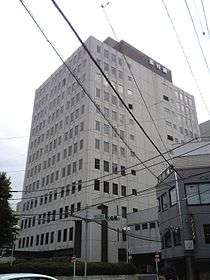Kumagai Gumi
 | |
 Kumagai Gumi headquarters in Tokyo | |
Native name | 株式会社熊谷組 |
|---|---|
| Public KK | |
| Traded as | TYO: 1861 |
| ISIN | JP3266800006 |
| Industry |
Construction Engineering |
| Founded | (January 1898, 01) in Fukui, Japan |
| Founder | Santaro Kumagai |
| Headquarters | Shinjuku-ku, Tokyo 162-8557, Japan |
Area served | Worldwide |
Key people |
Yasushi Higuchi (President) |
| Products |
|
| Services |
|
| Revenue | (US$ 3.07 billion) (FY 2016) |
|
| |
Number of employees | 3,798 (as of March 31, 2016) |
| Website | Official website |
|
Footnotes / references [1][2] | |
Kumagai Gumi Co., Ltd. (株式会社熊谷組 Kabushiki-gaisha Kumagai Gumi) is a Japanese construction company founded in Fukui, Fukui Prefecture, Japan. The company still has registered headquarters in Fukui, but the actual head office is located in Shinjuku, Tokyo.
History
Santaro Kumagai, the company's founder, began his career as a civil servant in a police department. His construction career started as a stonemason, crafting religious monuments and performing work for the expanding railway network.[3]
Kumagai founded his own company in 1898 and incorporated it in 1938. Between 1955 and 1983 the company accounted for more than 10% of all contracts awarded to the fifty-seven members of the Overseas Construction Association of Japan, a figure that outranked the ‘Big Five’ domestic giant construction companies.[4] As overseas projects were riskier, these five companies were reluctant to expand beyond Japan. Kumagai Gumi took advantage of the situation and sought work overseas, as both as a construction company and a developer, using BOT as project financing, becoming one of the leading proponents of BOT in Southeast Asia. By 1985 overseas earnings amounted to 46% of Kumagai's total contracts.[5]
In the 1980s the company became the largest Japanese real estate investor in New York City,[6] investing in projects in Manhattan, including in projects developed by William Zeckendorf, Jr..[7]
Major works
Dams and railways
- Tokuyama Dam
- Mass Transit Railway - Hong Kong (numerous contracts)
- Delhi Metro Yellow line - Delhi[8]
- Taipei Metro Bannan Line - Taipei[9]
- Bangkok Metropolitan Rapid Transit Blue Line - Bangkok[9]
- Marmaray rail link - Istanbul[10]
Tunnels
- Seikan Tunnel
- Sydney Harbour Tunnel - Sydney[11]
- Eastern Harbour Crossing - Hong Kong[3]
- Western Harbour Crossing - Hong Kong
- Eagle's Nest Tunnel - Hong Kong[12]
Skyscrapers
- Taipei 101 - Taipei[13]
- Bank of China Tower - Hong Kong[14]
- Shun Hing Square - Shenzen[15]
- CITIC Plaza - Guangzhou[16]
- Dayabumi Complex - Kuala Lumpur
- Bank of China Tower - Shanghai
References
- ↑ "Corporate Profile". Kumagai Gumi. Retrieved August 30, 2017.
- ↑ "Company Profile". Nikkei Asian Review. Nikkei Inc. Retrieved August 30, 2017.
- 1 2 Levy, Sidney M. (September 27, 1996). Build, Operate, Transfer: Paving the Way for Tomorrow's Infrastructure. John Wiley & Sons. pp. 286–287. ISBN 978-0-471-11992-0.
- ↑ Rimmer, Peter J. (March 1, 1990). "The Internationalisation of the Japanese Construction Industry: The Rise and Rise of Kumagai Gumi". Environment and Planning A. SAGE Publications. 22 (3). doi:10.1068/a220345. Retrieved August 31, 2017.
- ↑ Smith, Michael P. (January 1, 1989). Pacific Rim Cities in the World Economy. Transaction Publishers. p. 180. ISBN 978-1-4128-3042-3.
- ↑ Levy, Sidney M. (December 6, 2012). Japanese Construction: An American Perspective. Springer Science & Business Media. p. 5. ISBN 978-1-4684-6665-2.
- ↑ Lyons, Richard D. (July 13, 1986). "The Zeckendorf Flag Flying High Again". The New York Times. Retrieved August 31, 2017.
- ↑ Zubko, Katherine C.; Sahay, Raj R. (September 16, 2010). Inside the Indian Business Mind: A Tactical Guide for Managers: A Tactical Guide for Managers. ABC-CLIO. p. 13. ISBN 978-0-313-37830-0.
- 1 2 Messe München (January 1, 1998). Tunnel Construction. CRC Press. pp. 73–81. ISBN 978-90-5410-951-8.
- ↑ Brunn, Stanley D. (March 19, 2011). Engineering Earth: The Impacts of Megaengineering Projects. Springer Science & Business Media. p. 727. ISBN 978-90-481-9920-4.
- ↑ Levy, Sidney M. (December 6, 2012). Japanese Construction: An American Perspective. Springer Science+Business Media. p. 131. ISBN 978-1-4684-6665-2.
- ↑ World Highways. Route One Publishing. 2004.
- ↑ Binder, Georges (2006). 101 of the World's Tallest Buildings. Images Publishing. p. 27. ISBN 978-1-86470-173-9.
- ↑ Binder, Georges (2006). 101 of the World's Tallest Buildings. Images Publishing. p. 47. ISBN 978-1-86470-173-9.
- ↑ Binder, Georges (2006). 101 of the World's Tallest Buildings. Images Publishing. p. 41. ISBN 978-1-86470-173-9.
- ↑ Binder, Georges (2006). 101 of the World's Tallest Buildings. Images Publishing. p. 39. ISBN 978-1-86470-173-9.
External links
- (in English) Kumagai Gumi
- (in Japanese) Kumagai Gumi